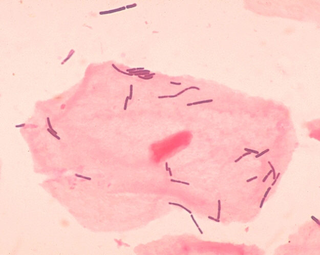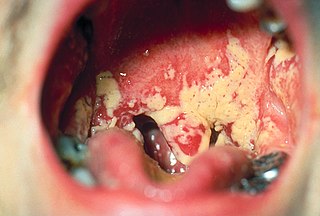Related Research Articles

The human microbiome is the aggregate of all microbiota that reside on or within human tissues and biofluids along with the corresponding anatomical sites in which they reside, including the skin, mammary glands, seminal fluid, uterus, ovarian follicles, lung, saliva, oral mucosa, conjunctiva, biliary tract, and gastrointestinal tract. Types of human microbiota include bacteria, archaea, fungi, protists, and viruses. Though micro-animals can also live on the human body, they are typically excluded from this definition. In the context of genomics, the term human microbiome is sometimes used to refer to the collective genomes of resident microorganisms; however, the term human metagenome has the same meaning.

Actinomyces is a genus of the Actinomycetia class of bacteria. They all are gram-positive. Actinomyces species are facultatively anaerobic and they grow best under anaerobic conditions. Actinomyces species may form endospores, and while individual bacteria are rod-shaped, Actinomyces colonies form fungus-like branched networks of hyphae. The aspect of these colonies initially led to the incorrect assumption that the organism was a fungus and to the name Actinomyces, "ray fungus".
The anal glands or anal sacs are small glands near the anus in many mammals. They are situated in between the external anal sphincter muscle and internal anal sphincter muscle. Their function in humans is unclear.
Ampicillin/sulbactam is a fixed-dose combination medication of the common penicillin-derived antibiotic ampicillin and sulbactam, an inhibitor of bacterial beta-lactamase. Two different forms of the drug exist. The first, developed in 1987 and marketed in the United States under the brand name Unasyn, generic only outside the United States, is an intravenous antibiotic. The second, an oral form called sultamicillin, is marketed under the brand name Ampictam outside the United States, and generic only in the United States. Ampicillin/sulbactam is used to treat infections caused by bacteria resistant to beta-lactam antibiotics. Sulbactam blocks the enzyme which breaks down ampicillin and thereby allows ampicillin to attack and kill the bacteria.

Gut microbiota, gut microbiome, or gut flora, are the microorganisms, including bacteria, archaea, fungi, and viruses, that live in the digestive tracts of animals. The gastrointestinal metagenome is the aggregate of all the genomes of the gut microbiota. The gut is the main location of the human microbiome. The gut microbiota has broad impacts, including effects on colonization, resistance to pathogens, maintaining the intestinal epithelium, metabolizing dietary and pharmaceutical compounds, controlling immune function, and even behavior through the gut–brain axis.

Peptostreptococcus is a genus of anaerobic, Gram-positive, non-spore forming bacteria. The cells are small, spherical, and can occur in short chains, in pairs or individually. They typically move using cilia. Peptostreptococcus are slow-growing bacteria with increasing resistance to antimicrobial drugs. Peptostreptococcus is a normal inhabitant of the healthy lower reproductive tract of women.

Bacteria are ubiquitous, mostly free-living organisms often consisting of one biological cell. They constitute a large domain of prokaryotic microorganisms. Typically a few micrometres in length, bacteria were among the first life forms to appear on Earth, and are present in most of its habitats. Bacteria inhabit soil, water, acidic hot springs, radioactive waste, and the deep biosphere of Earth's crust. Bacteria play a vital role in many stages of the nutrient cycle by recycling nutrients and the fixation of nitrogen from the atmosphere. The nutrient cycle includes the decomposition of dead bodies; bacteria are responsible for the putrefaction stage in this process. In the biological communities surrounding hydrothermal vents and cold seeps, extremophile bacteria provide the nutrients needed to sustain life by converting dissolved compounds, such as hydrogen sulphide and methane, to energy. Bacteria also live in symbiotic and parasitic relationships with plants and animals. Most bacteria have not been characterised and there are many species that cannot be grown in the laboratory. The study of bacteria is known as bacteriology, a branch of microbiology.
Mycobacteroides chelonae is a species of bacteria from the phylum Actinomycetota belonging to the genus Mycobacteroides. Mycobacteroides chelonae is a rapidly growing mycobacterium that is found all throughout the environment, including sewage and tap water. It can occasionally cause opportunistic infections of humans. It is grouped in Runyon group IV.

Vaginal flora, vaginal microbiota or vaginal microbiome are the microorganisms that colonize the vagina. They were discovered by the German gynecologist Albert Döderlein in 1892 and are part of the overall human flora. The amount and type of bacteria present have significant implications for an individual's overall health. The primary colonizing bacteria of a healthy individual are of the genus Lactobacillus, such as L. crispatus, and the lactic acid they produce is thought to protect against infection by pathogenic species.

Oral microbiology is the study of the microorganisms (microbiota) of the oral cavity and their interactions between oral microorganisms or with the host. The environment present in the human mouth is suited to the growth of characteristic microorganisms found there. It provides a source of water and nutrients, as well as a moderate temperature. Resident microbes of the mouth adhere to the teeth and gums to resist mechanical flushing from the mouth to stomach where acid-sensitive microbes are destroyed by hydrochloric acid.

Pathogenic bacteria are bacteria that can cause disease. This article focuses on the bacteria that are pathogenic to humans. Most species of bacteria are harmless and are often beneficial but others can cause infectious diseases. The number of these pathogenic species in humans is estimated to be fewer than a hundred. By contrast, several thousand species are part of the gut flora present in the digestive tract.
Anaerobic infections are caused by anaerobic bacteria. Obligately anaerobic bacteria do not grow on solid media in room air ; facultatively anaerobic bacteria can grow in the presence or absence of air. Microaerophilic bacteria do not grow at all aerobically or grow poorly, but grow better under 10% carbon dioxide or anaerobically. Anaerobic bacteria can be divided into strict anaerobes that can not grow in the presence of more than 0.5% oxygen and moderate anaerobic bacteria that are able of growing between 2 and 8% oxygen. Anaerobic bacteria usually do not possess catalase, but some can generate superoxide dismutase which protects them from oxygen.
Staphylococcus saccharolyticus is a Gram-positive, coagulase-negative, anaerobic member of the bacterial genus Staphylococcus consisting of single and clustered cocci. The species was formerly known as Peptococcus saccharolyticus, but was reclassified on the basis of 16S ribosomal RNA and biochemical similarity to other members of Staphylococcus.
Peptoniphilus asaccharolyticus is a species of bacteria belonging to the family Peptoniphilaceae. The cells are small, spherical, and can occur in short chains, in pairs or individually. Peptostreptococcus are slow-growing bacteria sometimes resistant to antimicrobial drugs.
Peptostreptococcus anaerobius is a species of bacteria belonging to the Peptostreptococcus genus of anaerobic, Gram-positive, non-spore forming bacteria. The cells are small, spherical, and can occur in short chains, in pairs or individually. Peptostreptococcus are slow-growing bacteria sometimes resistance to antimicrobial drugs. P. anaerobius is intrinsically resistant to sodium polyethanol sulfonate (SPS), a component found in many types of blood culture media.
Peptoniphilus is a genus of bacteria in the phylum Bacillota (Bacteria).
Finegoldia is a genus of Gram-positive bacteria. They are anaerobic cocci of the class Clostridia, with Finegoldia magna being the type species. F. magna was formerly known, along with several other Gram-positive anaerobic cocci (GPACs), as Peptostreptococcus magnus, but was moved into its own genus in 1999. The name is in honor of Sydney M. Finegold, an American microbiologist, while magna is Latin for large. It is an opportunistic human pathogen that normally colonizes skin and mucous membranes. It is often seen in biofilms on chronic ulcers such as in diabetic foot or decubitus ulcers. Most surveys have found it to be susceptible to penicillins, carbapenems and metronidazole, though resistant strains have been identified. Resistance to clindamycin is common and has been seen in over 10% of isolates in the US. One review stated that "the combination of diminished antimicrobial susceptibility, its prevalence, and the described virulence factors gives F. magna a special position among the GPAC."
Anaerococcus is a genus of bacteria. Its type species is Anaerococcus prevotii. These bacteria are Gram-positive and strictly anaerobic. The genus Anaerococcus was proposed in 2001. Its genome was sequenced in August 2009. The genus Anaerococcus is one of six genera classified within the group GPAC. These six genera are found in the human body as part of the commensal human microbiota.
Anaerococcus tetradius is a bacterium from the family Peptoniphilaceae. It was first isolated from vaginal discharges and ovarian abscesses, but is a common member of the vaginal flora.
References
- ↑ EZAKI*, TAKAYUKI; YAMAMOTO, NAOKI; NINOMIYA, KEIU; SUZUKI, SHOICHIRO; YABUUCHI, EIKOYR 1983 (1983). "Transfer of Peptococcus indolicus, Peptococcus asaccharolyticus, Peptococcus prevotii, and Peptococcus magnus to the Genus Peptostreptococcus and Proposal of Peptostreptococcus tetradius sp. nov". International Journal of Systematic and Evolutionary Microbiology. 33 (4): 683–698. doi: 10.1099/00207713-33-4-683 . ISSN 1466-5034.